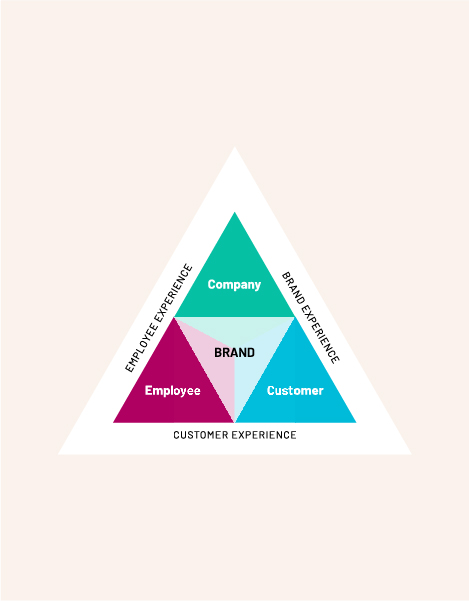Creating Your Ideal Workplace: 4 Tips for Enhancing Employee Experience

Every organization knows certain desired mindsets and behaviors are needed to achieve business success and stay true to its brand. But where do you start when those mindsets and behaviors exhibited at your organization don’t quite align with your brand or the characteristics and attributes you desire?
Ultimately, your employee experience cultivates these mindsets and behaviors or it doesn’t. So, with the right employee experience efforts, any organization can intentionally craft a workplace environment that reflects its brand, attracts people who exhibit its ideal mindsets and behaviors and helps develop or reinforce them within each person. Here’s how to get started.
Evaluate what you can control within your work environment.
Unlike workplace “culture,” employee experience is a purely intentional endeavor aimed at aligning the holistic employee journey with an organization’s brand in a manner that strengthens recruitment, retention and overall satisfaction. At its essence, employee experience revolves around the simple concept that happy employees do better work. And employees “touch and feel” these alignment efforts throughout their employment, particularly in their day-to-day work life.
And because of that intentionality, employee experience is influenced by elements that remain within the organization’s control.
Successful garden growers don’t anticipate prize-winning vegetables by leaving their results to the rain. They create an entire environment geared toward that outcome—establishing plots, adding nutrients to the soil, providing supplemental watering, weeding and removing obstacles to growth. Those elements they can control—but the weather, not so much.
Similarly, organizations won’t find success by leaving their desired employee mindsets and behaviors to chance. Employees will struggle to deliver or understand what’s asked of them if they lack the support needed to achieve those outcomes. And organizations are more likely to experience negative effects this way, such as employee confusion, stress, dissatisfaction, resentment and job security fears—which are more likely to drive away their ideal employees instead.
So for employee experience success, organizations first need to evaluate and then implement initiatives based on what’s controllable. To start, consider your systems, rituals, cues and communications.
Your systems and structures
An organization’s systems and structures refer to the processes, policies and resources that employees follow, interact with and use. These elements generally involve the most significant effort, as they’re part of an organization’s infrastructure—from rules and regulations to the technology platforms used to get work done.
Systems establish guardrails for employee behaviors and help ensure everyone stays between them. For example, if your organization’s product requires a significant amount of quality control and inspection, diligence and exacting standards may be traits you want associated with your brand and showcased by your employees.
But does this quality control have a formalized process? Or are employees merely tasked to “ensure standards are met” without:
- Those standards being explicitly defined
- An outline of what the process requires (e.g., process order, common issues to beware of)
- Reliable, well-maintained tools and equipment
- Engaging and accessible training
Organizations must provide this type of direction as an inherent part of building and maintaining its systems and structures. Of course, the systems and resources need to be understood and widely adopted as well—they’re only helpful if your employees actually use them.
Your rituals
An organization’s rituals are the interactions between employees and the organization that form connections. By establishing and designing connected experiences, rituals help build relationships between individuals, which they then come to associate with the organization, its brand and its employee experience.
For example, if an organization’s brand values include empathy, then there should be an emphasis on forming personal connections within work settings and the importance of addressing colleagues’ personal needs and desires. Perhaps managers are trained and coached to remain actively curious about their team’s needs and feelings in real time. This might involve checking in on team members at the start of a meeting or reiterating that they’re available to talk through anything that comes up.
The interactions between employees and the organization are broadly broken down into dynamics involving:
- The organization and all personnel (e.g., “all-hands” meetings)
- Managers and team members (e.g., weekly status meetings, Friday wrap-ups)
- One-on-ones (e.g., meetings between managers and direct reports)
- Employees within a team (e.g. brainstorming sessions, feedback norms)
- Social, nonwork activities, which are driven by employees (e.g., Happy Hour, birthday celebrations, book clubs)
Crucially, organizations need to provide managers with the resources and training necessary to “conduct” rituals in a manner that aligns with your employee experience goals (and, by extension, the brand). The situation for managers reflects that for other employees—leaving their role to chance forces managers to come up with their own methods for leadership and management. And this leads to an inconsistent (if not contradictory) execution of the employee experience the organization is designing so intentionally.
Your cues
Cues are ever-present for employees—they’re the little triggers and reminders that are part of their work lives. They help set and reinforce expectations. Cues can take on any number of forms and may be:
- Environmental, such as office decor or signage
- Physical items, like branded stress balls or T-shirts
- Digital resources, including company-branded backgrounds for virtual meetings
- Behavioral norms (verbal and nonverbal), which are consciously or unconsciously understood across the organization
For example, companies commonly adopt the environmental cue of displaying their motto at the building’s entrance to help employees adopt the right mindset and mentally prepare for their day as they arrive. Another typical cue is a closed office door, indicating the person is “heads-down” on a project and can’t be interrupted, whereas an open door indicates collaboration and question-asking are welcome at that time.
Still, these cues and the decision-making behind their implementation don’t exist in a vacuum. Cues must be defined and communicated to employees in order to support the behaviors they’re intended to trigger or remind.
Your communications
Communication includes the messaging that organizations use internally and how employees receive that information.
Most importantly, communications should always be regarded as opportunities for employees to foster deeper connections with brands. It’s not enough to dryly convey information; the messaging (in both content and tone) and expression needs to reflect the organization’s brand.
To that end, an organization’s internal communications should inspire, inform and guide its employees.
And your communications are inherently tied to all other employee experience efforts. Any initiatives’ success depends on employees’ understanding and embodiment of them—requiring organizations to communicate about changes and expected outcomes in advance and throughout rollouts. For example, if your company recently created digital backgrounds for video conferences, do employees know how to access them or set them up?
Success involves meeting employees where they are.
Remember that achieving success with your employee experience efforts always involves meeting employees where they are. This should involve efforts to understand your employees’ needs, wants and preferences along with building mechanisms to continuously collect and track their feedback as its own employee experience initiative.
It’s a two-way relationship, and disregarding that (especially if employees don’t understand the purpose of a given system, ritual, cue or communication) will only create negative experiences and impact recruitment and retention. But done right, meeting employees where they are drives engagement, builds credibility for your efforts and fosters overall brand belief.
And when you do launch a new employee experience initiative, be sure to communicate why to help employees understand it and its targeted outcome. The why helps employees understand, embrace and, ultimately, embody the information. And with that information in mind, they’ll be better positioned to act in support of the initiative or make the changes you’re looking to see.
Embrace and embody your ideal mindsets and behaviors to mobilize employees.
The levers (systems, rituals, cues and communications) that organizations can pull affect every facet of the employee journey and ultimately influence mindsets and behaviors. In building your employee experience, they must be designed to encourage and actuate the mindsets and behaviors your organization desires and needs.
Done right, these employee experience levers mobilize employees toward achieving your brand’s purpose, aspirations and values—creating an organization where internal operations reflect and align with external activity—amplifying the resonance of both with their intended audiences from customers to employees.

